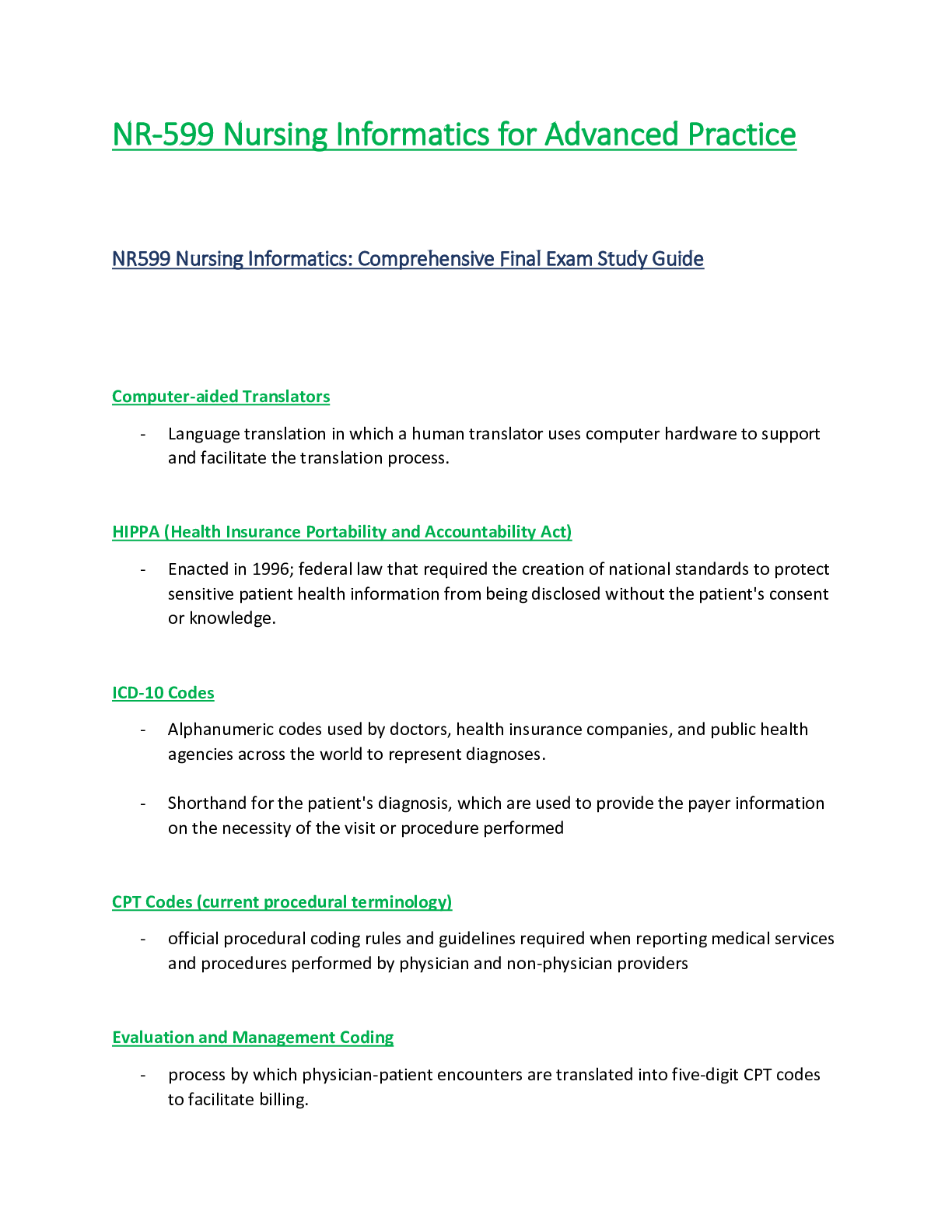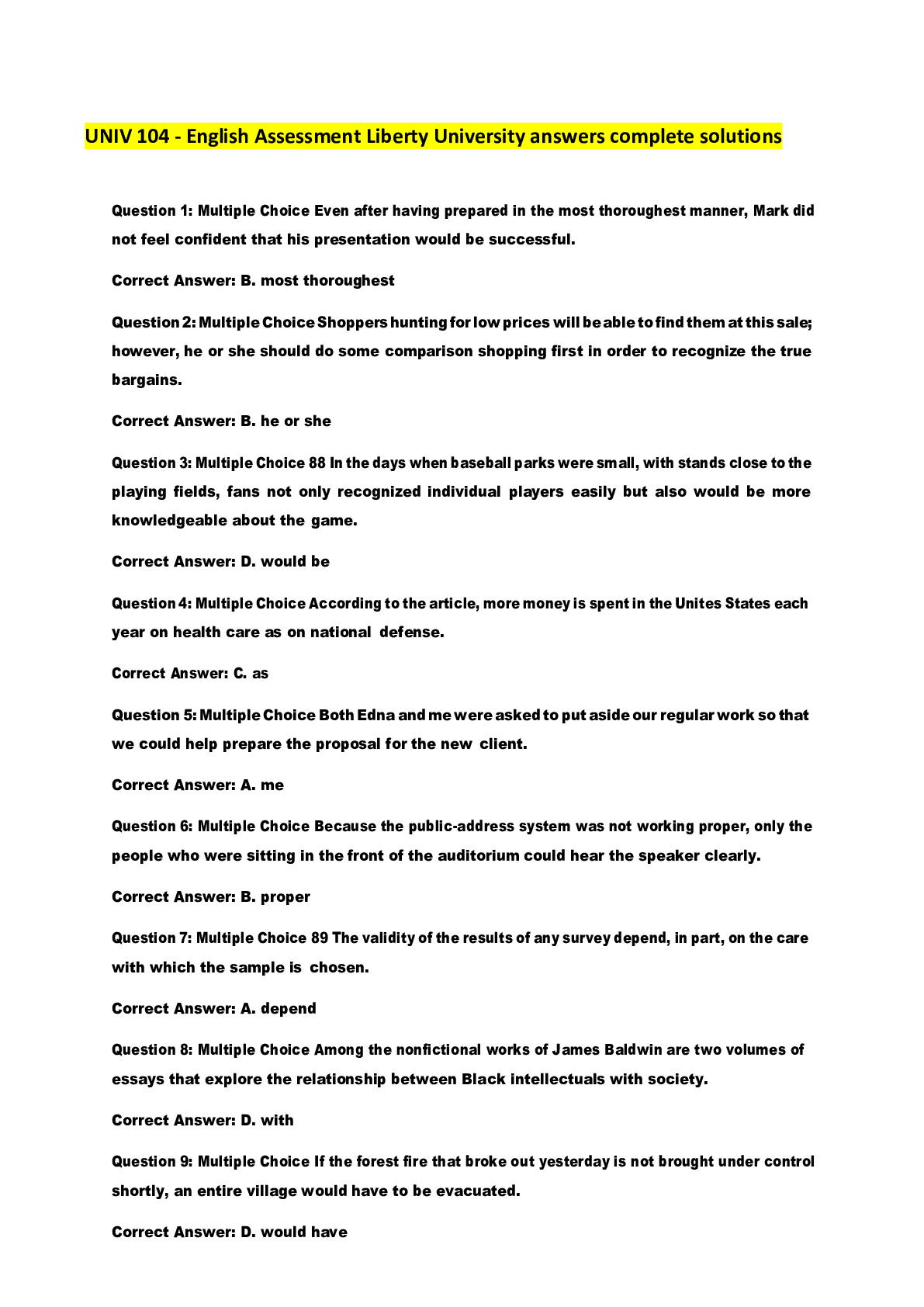*NURSING > STUDY GUIDE > NUR 2407 Health Assessment Test Bank. Complete Questions & Answers; Rasmussen College. (All)
NUR 2407 Health Assessment Test Bank. Complete Questions & Answers; Rasmussen College.
Document Content and Description Below
NUR 2407 Health Assessment Test Bank (2020) Chapter 01: Evidence-Based Assessment After completing an initial assessment of a patient, the nurse has charted that his respirations are eupneic and ... his pulse is 58 beats per minute. These types of data would be: A patient tells the nurse that he is very nervous, is nauseated, and “feels hot.” These types of data would be: The patient’s record, laboratory studies, objective data, and subjective data combine to form the: When listening to a patient’s breath sounds, the nurse is unsure of a sound that is heard. The nurse’s next action should be to: The nurse is conducting a class for new graduate nurses. During the teaching session, the nurse should keep in mind that novice nurses, without a background of skills and experience from which to draw, are more likely to make their decisions using: Expert nurses learn to attend to a pattern of assessment data and act without consciously labeling it. These responses are referred to as: The nurse is reviewing information about evidence-based practice (EBP). Which statement best reflects EBP? The nurse is conducting a class on priority setting for a group of new graduate nurses. Which is an example of a first-level priority problem? 1. When considering priority setting of problems, the nurse keeps in mind that second-level priority problems include which of these aspects? 2. Which critical thinking skill helps the nurse see relationships among the data? 3. The nurse knows that developing appropriate nursing interventions for a patient relies on the appropriateness of the __________ diagnosis. 4. The nursing process is a sequential method of problem solving that nurses use and includes which steps? 5. A newly admitted patient is in acute pain, has not been sleeping well lately, and is having difficulty breathing. How should the nurse prioritize these problems? 6. Which of these would be formulated by a nurse using diagnostic reasoning? 7. Barriers to incorporating EBP include: 8. What step of the nursing process includes data collection by health history, physical examination, and interview? 9. During a staff meeting, nurses discuss the problems with accessing research studies to incorporate evidence-based clinical decision making into their practice. Which suggestion by the nurse manager would best help these problems? 10. When reviewing the concepts of health, the nurse recalls that the components of holistic health include which of these? 11. The nurse recognizes that the concept of prevention in describing health is essential because: 12. The nurse is performing a physical assessment on a newly admitted patient. An example of objective information obtained during the physical assessment includes the: 13. A visiting nurse is making an initial home visit for a patient who has many chronic medical problems. Which type of data base is most appropriate to collect in this setting? a. A follow-up data base to evaluate changes at appropriate intervals b. An episodic data base because of the continuing, complex medical problems of this patient c. A complete health data base because of the nurse’s primary responsibility for monitoring the patient’s health d. An emergency data base because of the need to collect information and make accurate diagnoses rapidly 14. Which situation is most appropriate during which the nurse performs a focused or problem-centered history? a. Patient is admitted to the hospital for surgery the following day. 15. A patient is at the clinic to have her blood pressure checked. She has been coming to the clinic weekly since she changed medications 2 months ago. The nurse should: 16. A patient is brought by ambulance to the emergency department with multiple traumas received in an automobile accident. He is alert and cooperative, but his injuries are quite severe. How would the nurse proceed with data collection? 17. A 42-year-old patient of Asian descent is being seen at the clinic for an initial examination. The nurse knows that including cultural information in his health assessment is important to: 18. In the health promotion model, the focus of the health professional includes: 19. The nurse has implemented several planned interventions to address the nursing diagnosis of acute pain. Which would be the next appropriate action? 20. Which statement best describes a proficient nurse? A proficient nurse is one who: MULTIPLE RESPONSE 1. The nurse is reviewing data collected after an assessment. Of the data listed below, which would be considered related cues that would be clustered together during data analysis? Select all that apply. MATCHING 2. Put the following patient situations in order according to the level of priority. a. .A teenager who was stung by a bee during a soccer match is having trouble breathing. b. An older adult with a urinary tract infection is also showing signs of confusion and agitation. c. A patient newly diagnosed with type 2 diabetes mellitus does not know how to check his own blood glucose levels with a glucometer Chapter 04: The Complete Health History 1. The nurse is preparing to conduct a health history. Which of these statements best describes the purpose of a health history? 2. When the nurse is evaluating the reliability of a patient’s responses, which of these statements would be correct? The patient: 3. A 59-year-old patient tells the nurse that he has ulcerative colitis. He has been having “black stools” for the last 24 hours. How would the nurse best document his reason for seeking care? 4. A patient tells the nurse that she has had abdominal pain for the past week. What would be the nurse’s best response? 5. A 29-year-old woman tells the nurse that she has “excruciating pain” in her back. Which would be the nurse’s appropriate response to the woman’s statement? 6. In recording the childhood illnesses of a patient who denies having had any, which note by the nurse would be most accurate? 7. A female patient tells the nurse that she has had six pregnancies, with four live births at term and two spontaneous abortions. Her four children are still living. How would the nurse record this information? 8. A patient tells the nurse that he is allergic to penicillin. What would be the nurse’s best response to this information? 9. The nurse is taking a family history. Important diseases or problems about which the patient should be specifically asked include: 10. The review of systems provides the nurse with: 11. Which of these statements represents subjective data the nurse obtained from the patient regarding the patient’s skin? 12. The nurse is obtaining a history from a 30-year-old male patient and is concerned about health promotion activities. Which of these questions would be appropriate to use to assess health promotion activities for this patient? 13. Which of these responses might the nurse expect during a functional assessment of a patient whose leg is in a cast? 14. In response to a question about stress, a 39-year-old woman tells the nurse that her husband and mother both died in the past year. Which response by the nurse is most appropriate? 15. In response to a question regarding the use of alcohol, a patient asks the nurse why the nurse needs to know. What is the reason for needing this information? 16. The mother of a 16-month-old toddler tells the nurse that her daughter has an earache. What would be an appropriate response? 17. During an assessment of a patient’s family history, the nurse constructs a genogram. Which statement best describes a genogram? 18. A 5-year-old boy is being admitted to the hospital to have his tonsils removed. Which information should the nurse collect before this procedure? 19. As part of the health history of a 6-year-old boy at a clinic for a sports physical examination, the nurse reviews his immunization record and notes that his last measles-mumps-rubella (MMR) vaccination was at 15 months of age. What recommendation should the nurse make? 20. In obtaining a review of systems on a “healthy” 7-year-old girl, the health care provider knows that it would be important to include the: 21. When the nurse asks for a description of who lives with a child, the method of discipline, and the support system of the child, what part of the assessment is being performed? 22. The nurse is obtaining a health history on an 87-year-old woman. Which of the following areas of questioning would be most useful at this time? 23. The nurse is performing a review of systems on a 76-year-old patient. Which of these statements is correct for this situation? 24. A 90-year-old patient tells the nurse that he cannot remember the names of the medications he is taking or for what reason he is taking them. An appropriate response from the nurse would be: 25. The nurse is performing a functional assessment on an 82-year-old patient who recently had a stroke. Which of these questions would be most important to ask? 26. The nurse is preparing to do a functional assessment. Which statement best describes the purpose of a functional assessment? 27. The nurse is asking a patient for his reason for seeking care and asks about the signs and symptoms he is experiencing. Which of these is an example of a symptom? 28. A patient is describing his symptoms to the nurse. Which of these statements reflects a description of the setting of his symptoms? 29. During an assessment, the nurse uses the CAGE test. The patient answers “yes” to two of the questions. What could this be indicating? 30. The nurse is incorporating a person’s spiritual values into the health history. Which of these questions illustrates the “community” portion of the FICA (faith and belief, importance and influence, community, and addressing or applying in care) questions? 31. The nurse is preparing to complete a health assessment on a 16-year-old girl whose parents have brought her to the clinic. Which instruction would be appropriate for the parents before the interview begins? 32. The nurse is assessing a new patient who has recently immigrated to the United States. Which question is appropriate to add to the health history? MULTIPLE RESPONSE 1. The nurse is assessing a patient’s headache pain. Which questions reflect one or more of the critical characteristics of symptoms that should be assessed? Select all that apply. 2. The nurse is conducting a developmental history on a 5-year-old child. Which questions Chapter 05: Mental Status Assessment 1. During an examination, the nurse can assess mental status by which activity? 2. The nurse is assessing the mental status of a child. Which statement about children and mental status is true? 3. The nurse is assessing a 75-year-old man. As the nurse begins the mental status portion of the assessment, the nurse expects that this patient: 4. When assessing aging adults, the nurse knows that one of the first things that should be assessed before making judgments about their mental status is: 5. The nurse is preparing to conduct a mental status examination. Which statement is true regarding the mental status examination? 6. A woman brings her husband to the clinic for an examination. She is particularly worried because after a recent fall, he seems to have lost a great deal of his memory of recent events. Which statement reflects the nurse’s best course of action? 7. The nurse is conducting a patient interview. Which statement made by the patient should the nurse more fully explore during the interview? 8. A patient is admitted to the unit after an automobile accident. The nurse begins the mental status examination and finds that the patient has dysarthric speech and is lethargic. The nurse’s best approach regarding this examination is to: 9. A 19-year-old woman comes to the clinic at the insistence of her brother. She is wearing black combat boots and a black lace nightgown over the top of her other clothes. Her hair is dyed pink with black streaks throughout. She has several pierced holes in her nares and ears and is wearing an earring through her eyebrow and heavy black makeup. The nurse concludes that: 10. A patient has been in the intensive care unit for 10 days. He has just been moved to the medical-surgical unit, and the admitting nurse is planning to perform a mental status examination. During the tests of cognitive function, the nurse would expect that he: 11. During a mental status examination, the nurse wants to assess a patient’s affect. The nurse should ask the patient which question? 12. The nurse is planning to assess new memory with a patient. The best way for the nurse to do this would be to: 13. A 45-year-old woman is at the clinic for a mental status assessment. In giving her the Four Unrelated Words Test, the nurse would be concerned if she could not ____ four unrelated words ____. 14. During a mental status assessment, which question by the nurse would best assess a person’s judgment? 15. Which of these individuals would the nurse consider at highest risk for a suicide attempt? 16. The nurse is performing a mental status assessment on a 5-year-old girl. Her parents are undergoing a bitter divorce and are worried about the effect it is having on their daughter. Which action or statement might lead the nurse to be concerned about the girl’s mental status? 17. The nurse is assessing orientation in a 79-year-old patient. Which of these responses would lead the nurse to conclude that this patient is oriented? 18. The nurse is performing the Denver II screening test on a 12-month-old infant during a routine well-child visit. The nurse should tell the infant’s parents that the Denver II: 19. A patient drifts off to sleep when she is not being stimulated. The nurse can easily arouse her by calling her name, but the patient remains drowsy during the conversation. The best description of this patient’s level of consciousness would be: 20. A patient has had a cerebrovascular accident (stroke). He is trying very hard to communicate. He seems driven to speak and says, “I buy obie get spirding and take my train.” What is the best description of this patient’s problem? 21. A patient repeatedly seems to have difficulty coming up with a word. He says, “I was on my way to work, and when I got there, the thing that you step into that goes up in the air was so full that I decided to take the stairs.” The nurse will note on his chart that he is using or experiencing: 22. During an examination, the nurse notes that a patient is exhibiting flight of ideas. Which statement by the patient is an example of flight of ideas? 23. A patient describes feeling an unreasonable, irrational fear of snakes. His fear is so persistent that he can no longer comfortably look at even pictures of snakes and has made an effort to identify all the places he might encounter a snake and avoids them. The nurse recognizes that he: 24. A patient has been diagnosed with schizophrenia. During a recent interview, he shows the nurse a picture of a man holding a decapitated head. He describes this picture as horrifying but then laughs loudly at the content. This behavior is a display of: 25. During reporting, the nurse hears that a patient is experiencing hallucinations. Which is an example of a hallucination? 26. A 20-year-old construction worker has been brought into the emergency department with heat stroke. He has delirium as a result of a fluid and electrolyte imbalance. For the mental status examination, the nurse should first assess the patient’s: 27. A patient states, “I feel so sad all of the time. I can’t feel happy even doing things I used to like to do.” He also states that he is tired, sleeps poorly, and has no energy. To differentiate between a dysthymic disorder and a major depressive disorder, the nurse should ask which question? 28. A 26-year-old woman was robbed and beaten a month ago. She is returning to the clinic today for a follow-up assessment. The nurse will want to ask her which one of these questions? 29. The nurse is performing a mental status examination. Which statement is true regarding the assessment of mental status? 30. A 23-year-old patient in the clinic appears anxious. Her speech is rapid, and she is fidgety and in constant motion. Which of these questions or statements would be most appropriate for the nurse to use in this situation to assess attention span? 31. The nurse is planning health teaching for a 65-year-old woman who has had a cerebrovascular accident (stroke) and has aphasia. Which of these questions is most important to use when assessing mental status in this patient? 32. A 30-year-old female patient is describing feelings of hopelessness and depression. She has attempted self-mutilation and has a history of suicide attempts. She describes difficulty sleeping at night and has lost 10 pounds in the past month. Which of these statements or questions is the nurse’s best response in this situation? 33. The nurse is providing instructions to newly hired graduates for the mini–mental state examination (MMSE). Which statement best describes this examination? 34. The nurse discovers speech problems in a patient during an assessment. The patient has spontaneous speech, but it is mostly absent or is reduced to a few stereotypical words or sounds. This finding reflects which type of aphasia? 35. A patient repeats, “I feel hot. Hot, cot, rot, tot, got. I’m a spot.” The nurse documents this as an illustration of: 36. During an interview, the nurse notes that the patient gets up several times to wash her hands even though they are not dirty. This behavior is an example of: 37. The nurse is administering a Mini-Cog test to an older adult woman. When asked to draw a clock showing the time of 10:45, the patient drew a clock with the numbers out of order and with an incorrect time. This result indicates which finding? 38. During morning rounds, the nurse asks a patient, “How are you today?” The patient responds, “You today, you today, you today!” and mumbles the words. This speech pattern is an example of: MULTIPLE RESPONSE 1. The nurse is assessing a patient who is admitted with possible delirium. Which of these are manifestations of delirium? Select all that apply Chapter 08: Assessment Techniques and Safety in the Clinical Setting 1. When performing a physical assessment, the first technique the nurse will always use is: 2. The nurse is preparing to perform a physical assessment. Which statement is true about the physical assessment? The inspection phase: 3. The nurse is assessing a patient’s skin during an office visit. What part of the hand and technique should be used to best assess the patient’s skin temperature? 4. Which of these techniques uses the sense of touch to assess texture, temperature, moisture, and swelling when the nurse is assessing a patient? 5. The nurse is preparing to assess a patient’s abdomen by palpation. How should the nurse proceed? 6. The nurse would use bimanual palpation technique in which situation? 7. The nurse is preparing to percuss the abdomen of a patient. The purpose of the percussion is to assess the __________ of the underlying tissue. 8. The nurse is reviewing percussion techniques with a newly graduated nurse. Which technique, if used by the new nurse, indicates that more review is needed? 9. When percussing over the liver of a patient, the nurse notices a dull sound. The nurse should: 10. The nurse is unable to identify any changes in sound when percussing over the abdomen of an obese patient. What should the nurse do next? 11. The nurse hears bilateral loud, long, and low tones when percussing over the lungs of a 4-year-old child. The nurse should: 12. A patient has suddenly developed shortness of breath and appears to be in significant respiratory distress. After calling the physician and placing the patient on oxygen, which of these actions is the best for the nurse to take when further assessing the patient? 13. The nurse is teaching a class on basic assessment skills. Which of these statements is true regarding the stethoscope and its use? 14. The nurse is preparing to use a stethoscope for auscultation. Which statement is true regarding the diaphragm of the stethoscope? The diaphragm: 15. Before auscultating the abdomen for the presence of bowel sounds on a patient, the nurse should: 16. The nurse will use which technique of assessment to determine the presence of crepitus, swelling, and pulsations? 17. The nurse is preparing to use an otoscope for an examination. Which statement is true regarding the otoscope? The otoscope: 18. An examiner is using an ophthalmoscope to examine a patient’s eyes. The patient has astigmatism and is nearsighted. The use of which of these techniques would indicate that the examination is being correctly performed? 19. The nurse is unable to palpate the right radial pulse on a patient. The best action would be to: 20. The nurse is preparing to perform a physical assessment. The correct action by the nurse is reflected by which statement? The nurse: 21. A man is at the clinic for a physical examination. He states that he is “very anxious” about the physical examination. What steps can the nurse take to make him more comfortable? 22. When performing a physical examination, safety must be considered to protect the examiner and the patient against the spread of infection. Which of these statements describes the most appropriate action the nurse should take when performing a physical examination? 23. The nurse is examining a patient’s lower leg and notices a draining ulceration. Which of these actions is most appropriate in this situation? 24. During the examination, offering some brief teaching about the patient’s body or the examiner’s findings is often appropriate. Which one of these statements by the nurse is most appropriate? 25. The nurse keeps in mind that the most important reason to share information and to offer brief teaching while performing the physical examination is to help the: 26. The nurse is examining an infant and prepares to elicit the Moro reflex at which time during the examination? 27. When preparing to perform a physical examination on an infant, the nurse should: 28. A 6-month-old infant has been brought to the well-child clinic for a check-up. She is currently sleeping. What should the nurse do first when beginning the examination? 29. A 2-year-old child has been brought to the clinic for a well-child checkup. The best way for the nurse to begin the assessment is to: 30. The nurse is examining a 2-year-old child and asks, “May I listen to your heart now?” Which critique of the nurse’s technique is most accurate? 31. With which of these patients would it be most appropriate for the nurse to use games during the assessment, such as having the patient “blow out” the light on the penlight? 32. The nurse is preparing to examine a 4-year-old child. Which action is appropriate for this age group? 33. When examining a 16-year-old male teenager, the nurse should: 34. When examining an older adult, the nurse should use which technique? 35. The most important step that the nurse can take to prevent the transmission of microorganisms in the hospital setting is to: 36. Which of these statements is true regarding the use of Standard Precautions in the health care setting? 37. The nurse is preparing to assess a hospitalized patient who is experiencing significant shortness of breath. How should the nurse proceed with the assessment? 38. When examining an infant, the nurse should examine which area first? 39. While auscultating heart sounds, the nurse hears a murmur. Which of these instruments should be used to assess this murmur? 40. During an examination of a patient’s abdomen, the nurse notes that the abdomen is rounded and firm to the touch. During percussion, the nurse notes a drumlike quality of the sounds across the quadrants. This type of sound indicates: 41. The nurse is preparing to examine a 6-year-old child. Which action is most appropriate? 42. During auscultation of a patient’s heart sounds, the nurse hears an unfamiliar sound. The nurse should: MULTIPLE RESPONSE 1. The nurse is preparing to palpate the thorax and abdomen of a patient. Which of these statements describes the correct technique for this procedure? Select all that apply. Chapter 09: General Survey, Measurement, Vital Signs 1. The nurse is performing a general survey. Which action is a component of the general survey? 2. When measuring a patient’s weight, the nurse is aware of which of these guidelines? 3. A patient’s weekly blood pressure readings for 2 months have ranged between 124/84 mm Hg and 136/88 mm Hg, with an average reading of 126/86 mm Hg. The nurse knows that this blood pressure falls within which blood pressure category? 4. During an examination of a child, the nurse considers that physical growth is the best index of a child’s: 5. A 1-month-old infant has a head measurement of 34 cm and has a chest circumference of 32 cm. Based on the interpretation of these findings, the nurse would: 6. The nurse is assessing an 80-year-old male patient. Which assessment findings would be considered normal? 7. The nurse should measure rectal temperatures in which of these patients? 8. The nurse is preparing to measure the length, weight, chest, and head circumference of a 6-month-old infant. Which measurement technique is correct? 9. The nurse knows that one advantage of the tympanic membrane thermometer (TMT) is that: 10. When assessing an older adult, which vital sign changes occur with aging? 11. The nurse is examining a patient who is complaining of “feeling cold.” Which is a mechanism of heat loss in the body? 12. When measuring a patient’s body temperature, the nurse keeps in mind that body temperature is influenced by: 13. When evaluating the temperature of older adults, the nurse should remember which aspect about an older adult’s body temperature? 14. A 60-year-old male patient has been treated for pneumonia for the past 6 weeks. He is seen today in the clinic for an “unexplained” weight loss of 10 pounds over the last 6 weeks. The nurse knows that: 15. When assessing a 75-year-old patient who has asthma, the nurse notes that he assumes a tripod position, leaning forward with arms braced on the chair. On the basis of this observation, the nurse should: 16. Which of these actions illustrates the correct technique the nurse should use when assessing oral temperature with a mercury thermometer? 17. The nurse is taking temperatures in a clinic with a TMT. Which statement is true regarding use of the TMT? 18. To assess a rectal temperature accurately in an adult, the nurse would: 19. Which technique is correct when the nurse is assessing the radial pulse of a patient? The pulse is counted for: 20. When assessing a patient’s pulse, the nurse should also notice which of these characteristics? 21. When assessing the pulse of a 6-year-old boy, the nurse notices that his heart rate varies with his respiratory cycle, speeding up at the peak of inspiration and slowing to normal with expiration. The nurse’s next action would be to: 22. When assessing the force, or strength, of a pulse, the nurse recalls that the pulse: 23. The nurse is assessing the vital signs of a 20-year-old male marathon runner and documents the following vital signs: temperature–36° C; pulse–48 beats per minute; respirations–14 breaths per minute; blood pressure–104/68 mm Hg. Which statement is true concerning these results? 24. The nurse is assessing the vital signs of a 3-year-old patient who appears to have an irregular respiratory pattern. How should the nurse assess this child’s respirations? 25. A patient’s blood pressure is 118/82 mm Hg. He asks the nurse, “What do the numbers mean?” The nurse’s best reply is: 26. While measuring a patient’s blood pressure, the nurse recalls that certain factors, such as __________, help determine blood pressure. 27. A nurse is helping at a health fair at a local mall. When taking blood pressures on a variety of people, the nurse keeps in mind that: 28. The nurse notices a colleague is preparing to check the blood pressure of a patient who is obese by using a standard-sized blood pressure cuff. The nurse should expect the reading to: 29. A student is late for his appointment and has rushed across campus to the health clinic. The nurse should: 30. The nurse will perform a palpated pressure before auscultating blood pressure. The reason for this is to: 31. The nurse is taking an initial blood pressure reading on a 72-year-old patient with documented hypertension. How should the nurse proceed? 32. The nurse has collected the following information on a patient: palpated blood pressure–180 mm Hg; auscultated blood pressure–170/100 mm Hg; apical pulse–60 beats per minute; radial pulse–70 beats per minute. What is the patient’s pulse pressure? 33. When auscultating the blood pressure of a 25-year-old patient, the nurse notices the phase I Korotkoff sounds begin at 200 mm Hg. At 100 mm Hg, the Korotkoff sounds muffle. At 92 mm Hg, the Korotkoff sounds disappear. How should the nurse record this patient’s blood pressure? 34. A patient is seen in the clinic for complaints of “fainting episodes that started last week.” How should the nurse proceed with the examination? 35. A 70-year-old man has a blood pressure of 150/90 mm Hg in a lying position, 130/80 mm Hg in a sitting position, and 100/60 mm Hg in a standing position. How should the nurse evaluate these findings? 36. The nurse is helping another nurse to take a blood pressure reading on a patient’s thigh. Which action is correct regarding thigh pressure? 37. The nurse is preparing to measure the vital signs of a 6-month-old infant. Which action by the nurse is correct? 38. A 4-month-old child is at the clinic for a well-baby check-up and immunizations. Which of these actions is most appropriate when the nurse is assessing an infant’s vital signs? 39. The nurse is conducting a health fair for older adults. Which statement is true regarding vital sign measurements in aging adults? 40. In a patient with acromegaly, the nurse will expect to discover which assessment findings? 41. The nurse is performing a general survey of a patient. Which finding is considered normal? 42. The nurse is assessing children in a pediatric clinic. Which statement is true regarding the measurement of blood pressure in children? 43. What type of blood pressure measurement error is most likely to occur if the nurse does not check for the presence of an auscultatory gap? 44. When considering the concepts related to blood pressure, the nurse knows that the concept of mean arterial pressure (MAP) is best described by which statement? 45. A 75-year-old man with a history of hypertension was recently changed to a new antihypertensive drug. He reports feeling dizzy at times. How should the nurse evaluate his blood pressure? 46. Which of these specific measurements is the best index of a child’s general health? 47. The nurse is assessing an 8-year-old child whose growth rate measures below the third percentile for a child his age. He appears significantly younger than his stated age and is chubby with infantile facial features. Which condition does this child have? 48. The nurse is counting an infant’s respirations. Which technique is correct? 49. When checking for proper blood pressure cuff size, which guideline is correct? 50. During an examination, the nurse notices that a female patient has a round “moon” face, central trunk obesity, and a cervical hump. Her skin is fragile with bruises. The nurse determines that the patient has which condition? MULTIPLE RESPONSE 1. While measuring a patient’s blood pressure, the nurse uses the proper technique to obtain an accurate reading. Which of these situations will result in a falsely high blood pressure reading? Select all that apply. SHORT ANSWER 2. What is the pulse pressure for a patient whose blood pressure is 158/96 mm Hg and whose pulse rate is 72 beats per minute? Chapter 10: Pain Assessment: The Fifth Vital Sign 1. When evaluating a patient’s pain, the nurse knows that an example of acute pain would be: 2. Which statement indicates that the nurse understands the pain experienced by an older adult? 3. A 4-year-old boy is brought to the emergency department by his mother. She says he points to his stomach and says, “It hurts so bad.” Which pain assessment tool would be the best choice when assessing this child’s pain? 4. A patient states that the pain medication is “not working” and rates his postoperative pain at a 10 on a 1-to-10 scale. Which of these assessment findings indicates an acute pain response to poorly controlled pain? 5. A 60-year-old woman has developed reflexive sympathetic dystrophy after arthroscopic repair of her shoulder. A key feature of this condition is that the: 6. The nurse is assessing a patient’s pain. The nurse knows that the most reliable indicator of pain would be the: 7. A patient has had arthritic pain in her hips for several years since a hip fracture. She is able to move around in her room and has not offered any complaints so far this morning. However, when asked, she states that her pain is “bad this morning” and rates it at an 8 on a 1-to-10 scale. What does the nurse suspect? The patient: 8. The nurse is reviewing the principles of pain. Which type of pain is due to an abnormal processing of the pain impulse through the peripheral or central nervous system? 9. When assessing the quality of a patient’s pain, the nurse should ask which question? 10. When assessing a patient’s pain, the nurse knows that an example of visceral pain would be: 11. The nurse is reviewing the principles of nociception. During which phase of nociception does the conscious awareness of a painful sensation occur? 12. When assessing the intensity of a patient’s pain, which question by the nurse is appropriate? 13. A patient is complaining of severe knee pain after twisting it during a basketball game and is requesting pain medication. Which action by the nurse is appropriate? 14. The nurse knows that which statement is true regarding the pain experienced by infants? 15. A patient has been admitted to the hospital with vertebral fractures related to osteoporosis. She is in extreme pain. This type of pain would be classified as: MULTIPLE RESPONSE 1. During assessment of a patient’s pain, the nurse is aware that certain nonverbal behaviors are associated with chronic pain. Which of these behaviors are associated with chronic pain? Select all that apply. 2. During an admission assessment of a patient with dementia, the nurse assesses for pain because the patient has recently had several falls. Which of these are appropriate for the nurse to assess in a patient with dementia? Select all that apply. Chapter 11: Nutritional Assessment 1. The nurse recognizes which of these persons is at greatest risk for undernutrition? 2. When assessing a patient’s nutritional status, the nurse recalls that the best definition of optimal nutritional status is sufficient nutrients that: 3. The nurse is providing nutrition information to the mother of a 1-year-old child. Which of these statements represents accurate information for this age group? 4. A pregnant woman is interested in breastfeeding her baby and asks several questions about the topic. Which information is appropriate for the nurse to share with her? 5. A mother and her 13-year-old daughter express their concern related to the daughter’s recent weight gain and her increase in appetite. Which of these statements represents information the nurse should discuss with them? 6. The nurse is assessing a 30-year-old unemployed immigrant from an underdeveloped country who has been in the United States for 1 month. Which of these problems related to his nutritional status might the nurse expect to find? 7. For the first time, the nurse is seeing a patient who has no history of nutrition-related problems. The initial nutritional screening should include which activity? 8. A patient is asked to indicate on a form how many times he eats a specific food. This method describes which of these tools for obtaining dietary information? 9. The nurse is providing care for a 68-year-old woman who is complaining of constipation. What concern exists regarding her nutritional status? 10. During a nutritional assessment, why is it important for the nurse to ask a patient what medications he or she is taking? 11. A patient tells the nurse that his food simply does not have any taste anymore. The nurse’s best response would be: 12. The nurse is performing a nutritional assessment on a 15-year-old girl who tells the nurse that she is “so fat.” Assessment reveals that she is 5 feet 4 inches and weighs 110 pounds. The nurse’s appropriate response would be: 13. The nurse is discussing appropriate foods with the mother of a 3-year-old child. Which of these foods are recommended? 14. The nurse is reviewing the nutritional assessment of an 82-year-old patient. Which of these factors will most likely affect the nutritional status of an older adult? 15. When considering a nutritional assessment, the nurse is aware that the most common anthropometric measurements include: 16. If a 29-year-old woman weighs 156 pounds, and the nurse determines her ideal body weight to be 120 pounds, then how would the nurse classify the woman’s weight? 17. How should the nurse perform a triceps skinfold assessment? 18. In teaching a patient how to determine total body fat at home, the nurse includes instructions to obtain measurements of: 19. The nurse is evaluating patients for obesity-related diseases by calculating the waist-to-hip ratios. Which one of these patients would be at increased risk? 20. A 50-year-old woman with elevated total cholesterol and triglyceride levels is visiting the clinic to find out about her laboratory results. What would be important for the nurse to include in patient teaching in relation to these tests? 21. In performing an assessment on a 49-year-old woman who has imbalanced nutrition as a result of dysphagia, which data would the nurse expect to find? 22. A 21-year-old woman has been on a low-protein liquid diet for the past 2 months. She has had adequate intake of calories and appears well nourished. After further assessment, what would the nurse expect to find? 23. The nurse is performing a nutritional assessment on an 80-year-old patient. The nurse knows that physiologic changes can directly affect the nutritional status of the older adult and include: 24. Which of these interventions is most appropriate when the nurse is planning nutritional interventions for a healthy, active 74-year-old woman? 25. A 16-year-old girl is being seen at the clinic for gastrointestinal complaints and weight loss. The nurse determines that many of her complaints may be related to erratic eating patterns, eating predominantly fast foods, and high caffeine intake. In this situation, which is most appropriate when collecting current dietary intake information? 26. The nurse is preparing to measure fat and lean body mass and bone mineral density. Which tool is appropriate? 27. Which of these conditions is due to an inadequate intake of both protein and calories? 28. During an assessment of a patient who has been homeless for several years, the nurse notices that his tongue is magenta in color, which is an indication of a deficiency in what mineral and/or vitamin? 29. A 50-year-old patient has been brought to the emergency department after a housemate found that the patient could not get out of bed alone. He has lived in a group home for years but for several months has not participated in the activities and has stayed in his room. The nurse assesses for signs of undernutrition, and an x-ray study reveals that he has osteomalacia, which is a deficiency of: 30. An older adult patient in a nursing home has been receiving tube feedings for several months. During an oral examination, the nurse notes that patient’s gums are swollen, ulcerated, and bleeding in some areas. The nurse suspects that the patient has what condition? 31. The nurse is assessing the body weight as a percentage of ideal body weight on an adolescent patient who was admitted for suspected anorexia nervosa. The patient’s usual weight was 125 pounds, but today she weighs 98 pounds. The nurse calculates the patient’s ideal body weight and concludes that the patient is: MULTIPLE RESPONSE 1. The nurse is assessing a patient who is obese for signs of metabolic syndrome. This condition is diagnosed when three or more certain risk factors are present. Which of these assessment findings are risk factors for metabolic syndrome? Select all that apply. SHORT ANSWER 1. A patient has been unable to eat solid food for 2 weeks and is in the clinic today complaining of weakness, tiredness, and hair loss. The patient states that her usual weight is 175 pounds, but today she weighs 161 pounds. What is her recent weight change percentage? To calculate recent weight change percentage, use this formula: [Show More]
Last updated: 1 month ago
Preview 1 out of 23 pages
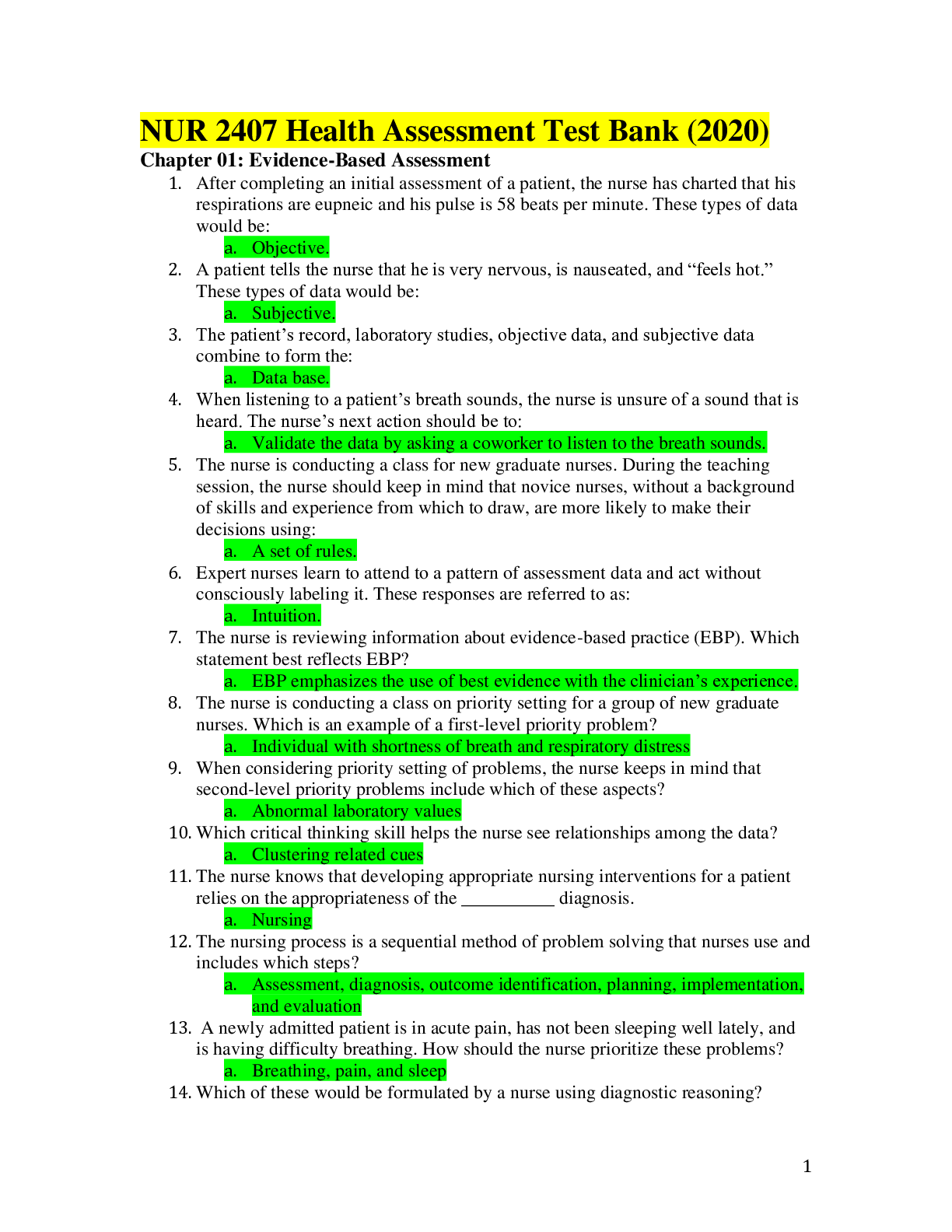
Reviews( 0 )
Document information
Connected school, study & course
About the document
Uploaded On
Apr 29, 2020
Number of pages
23
Written in
Additional information
This document has been written for:
Uploaded
Apr 29, 2020
Downloads
1
Views
352


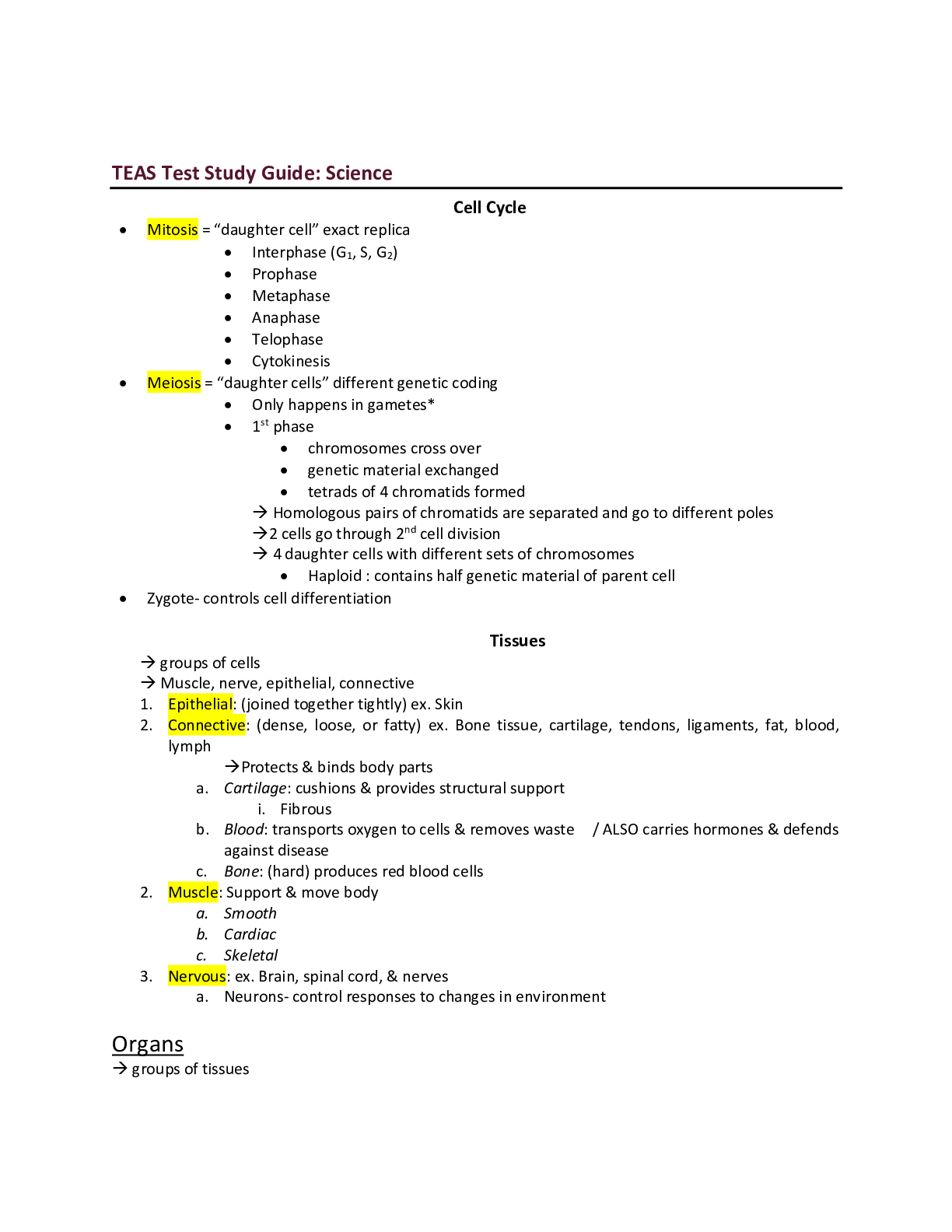


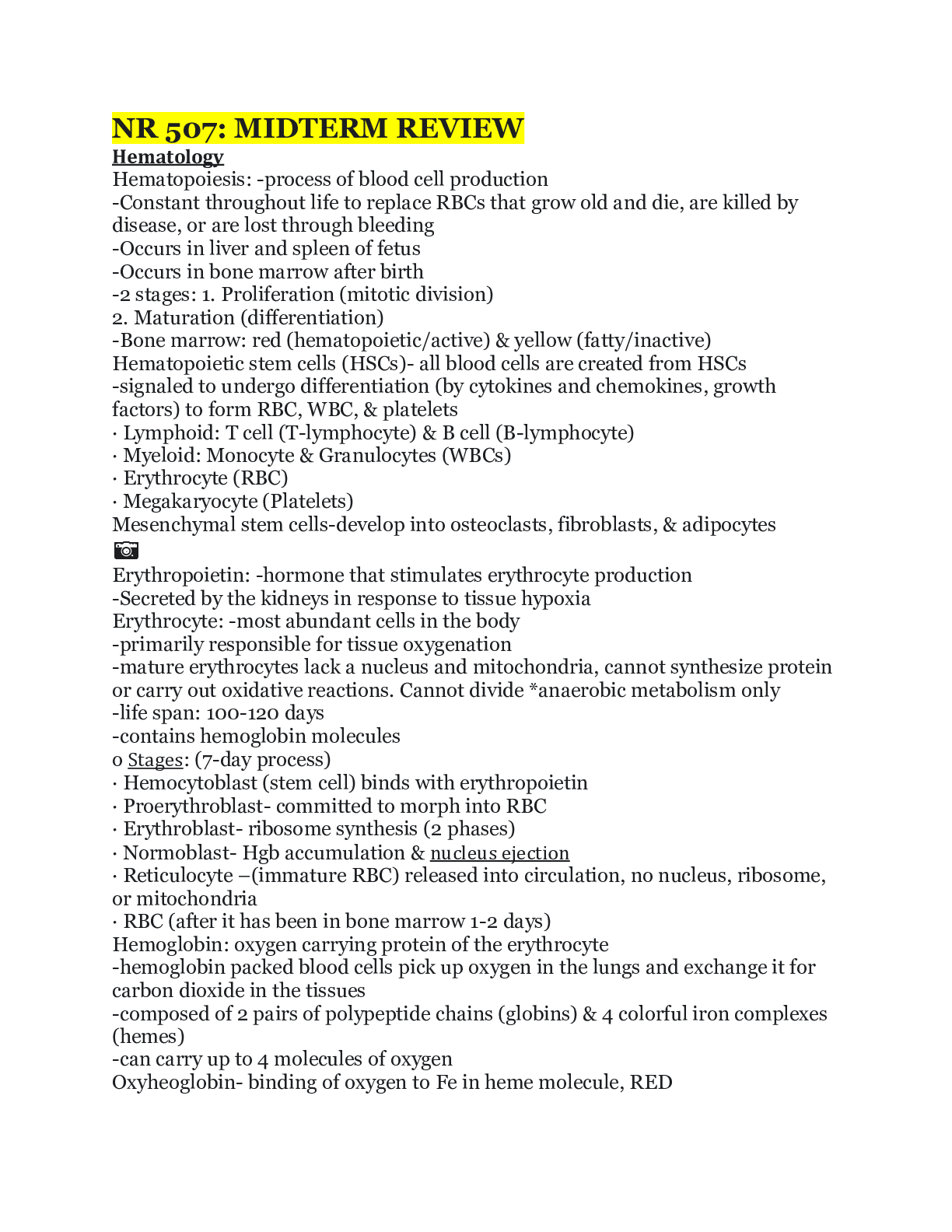

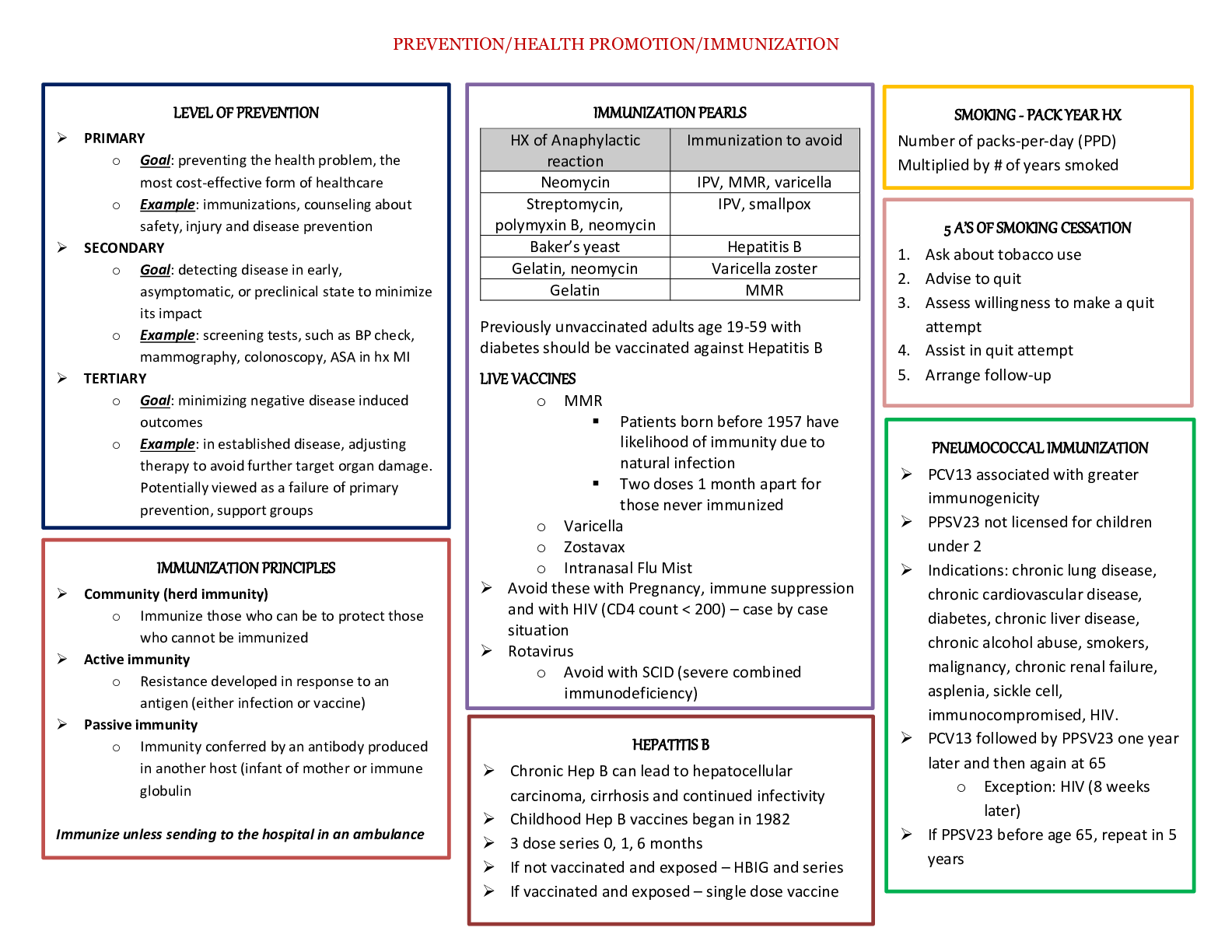
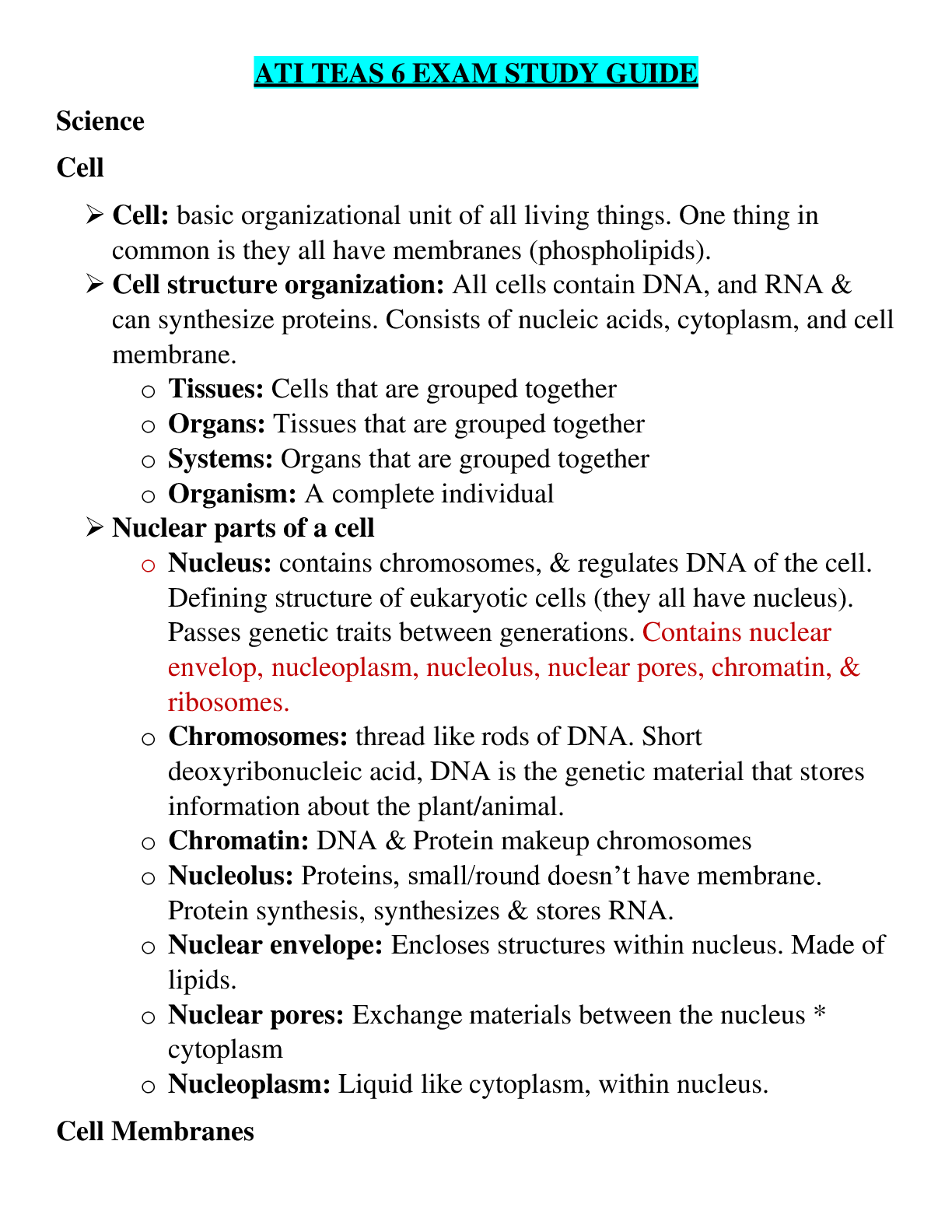


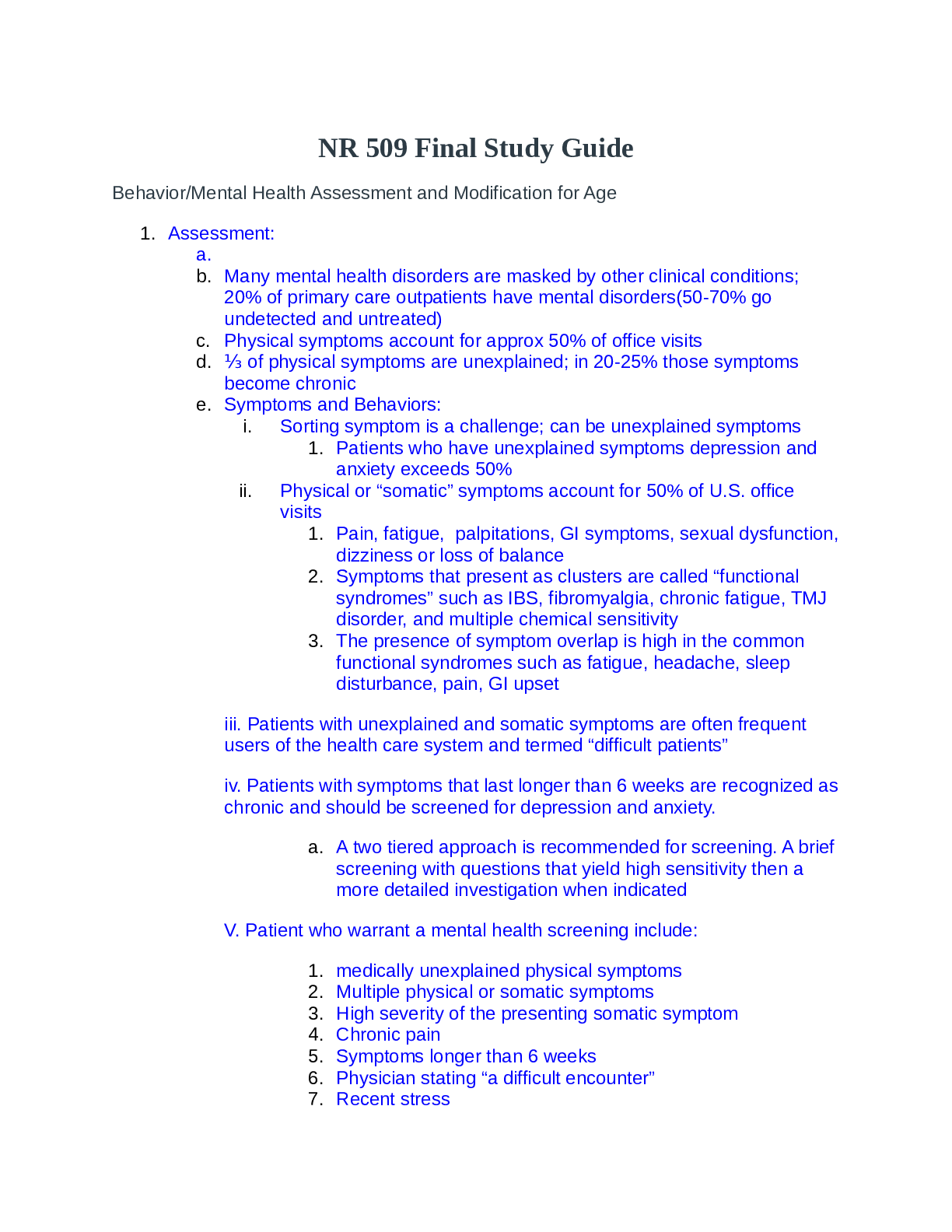
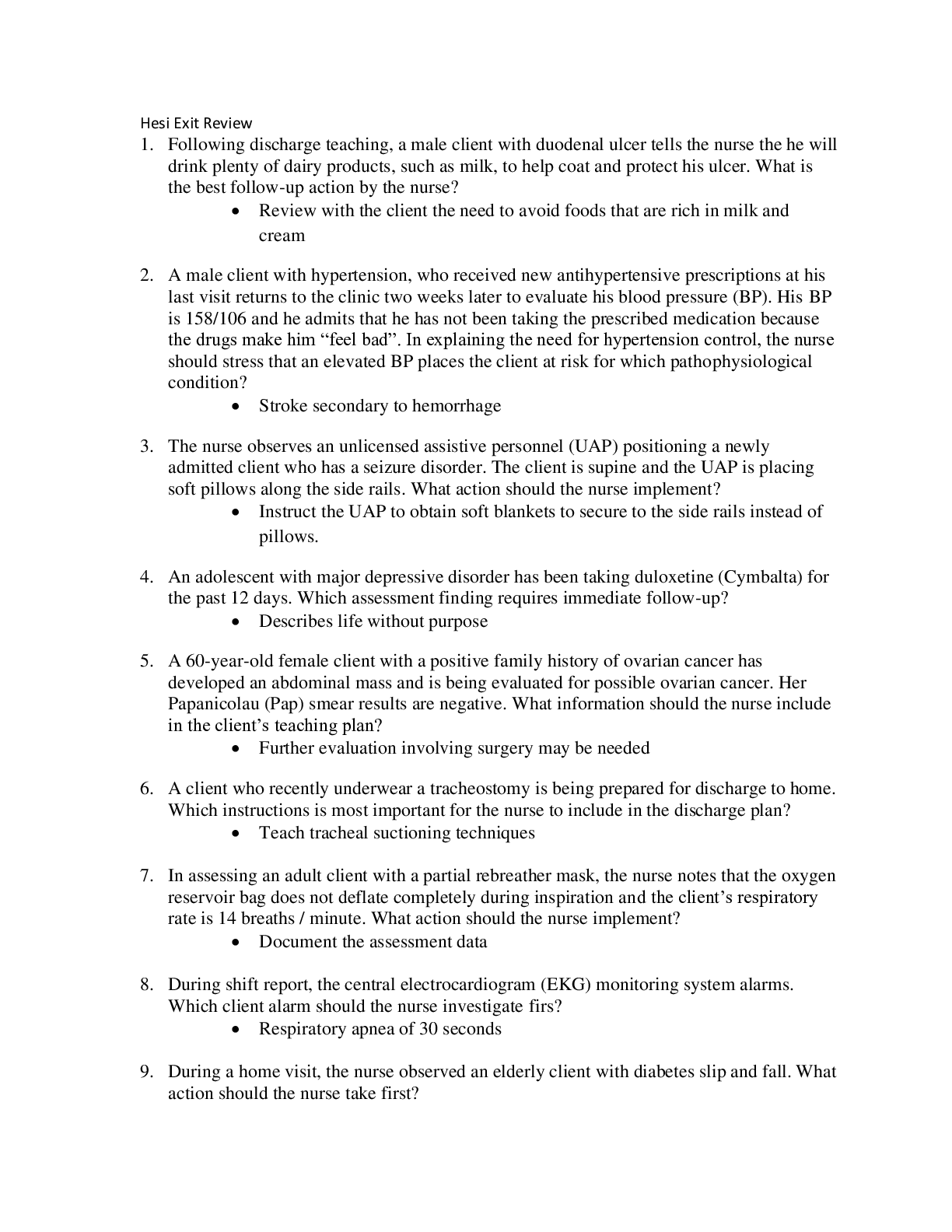
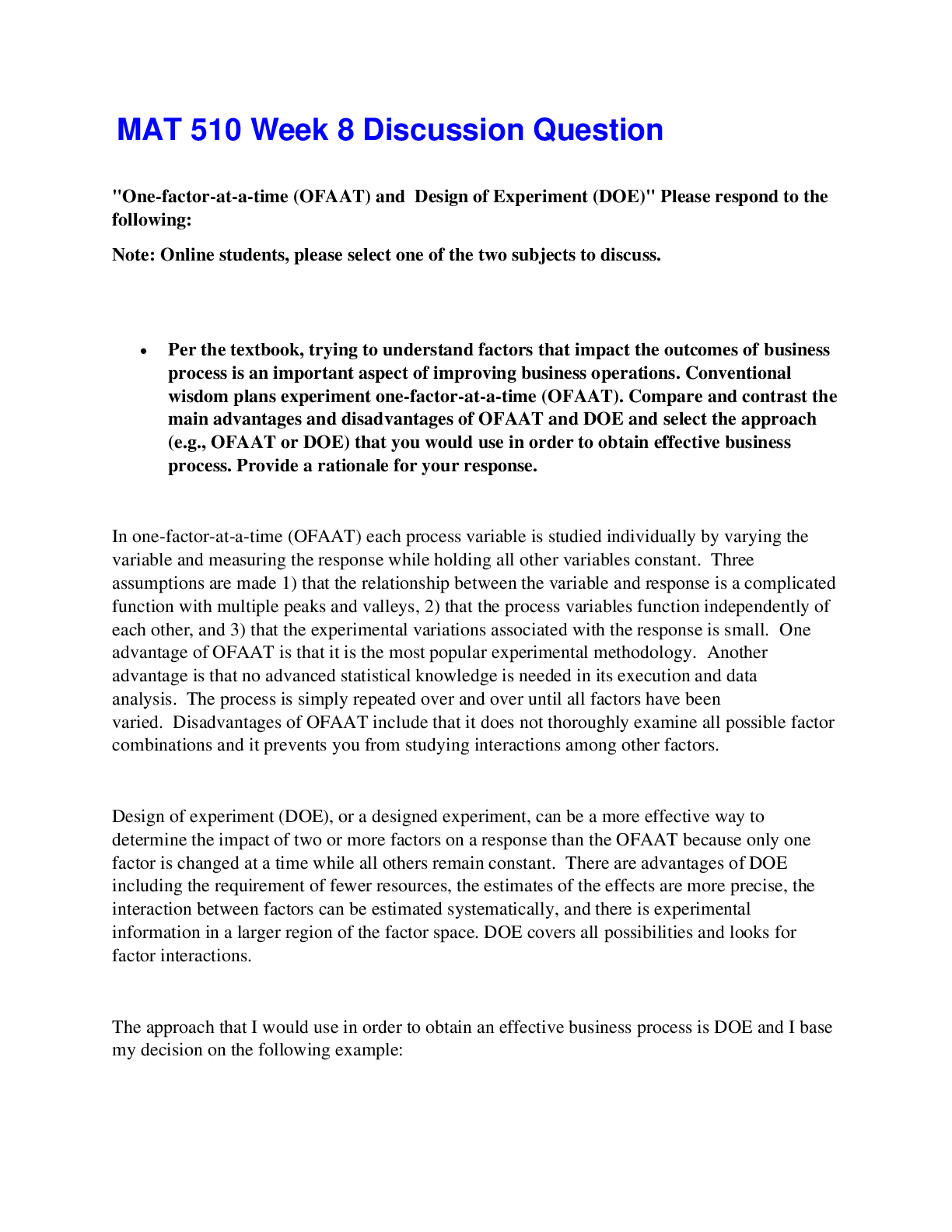

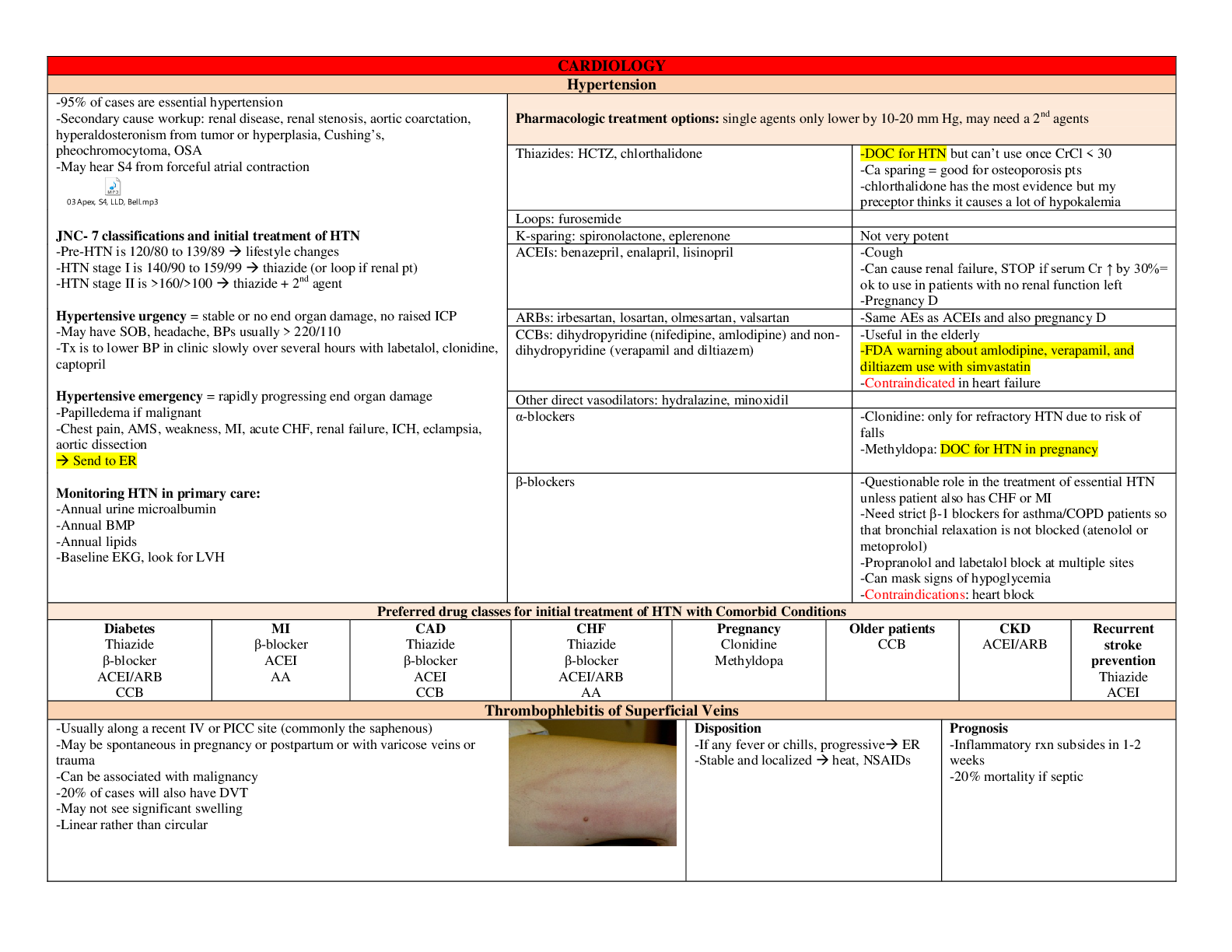




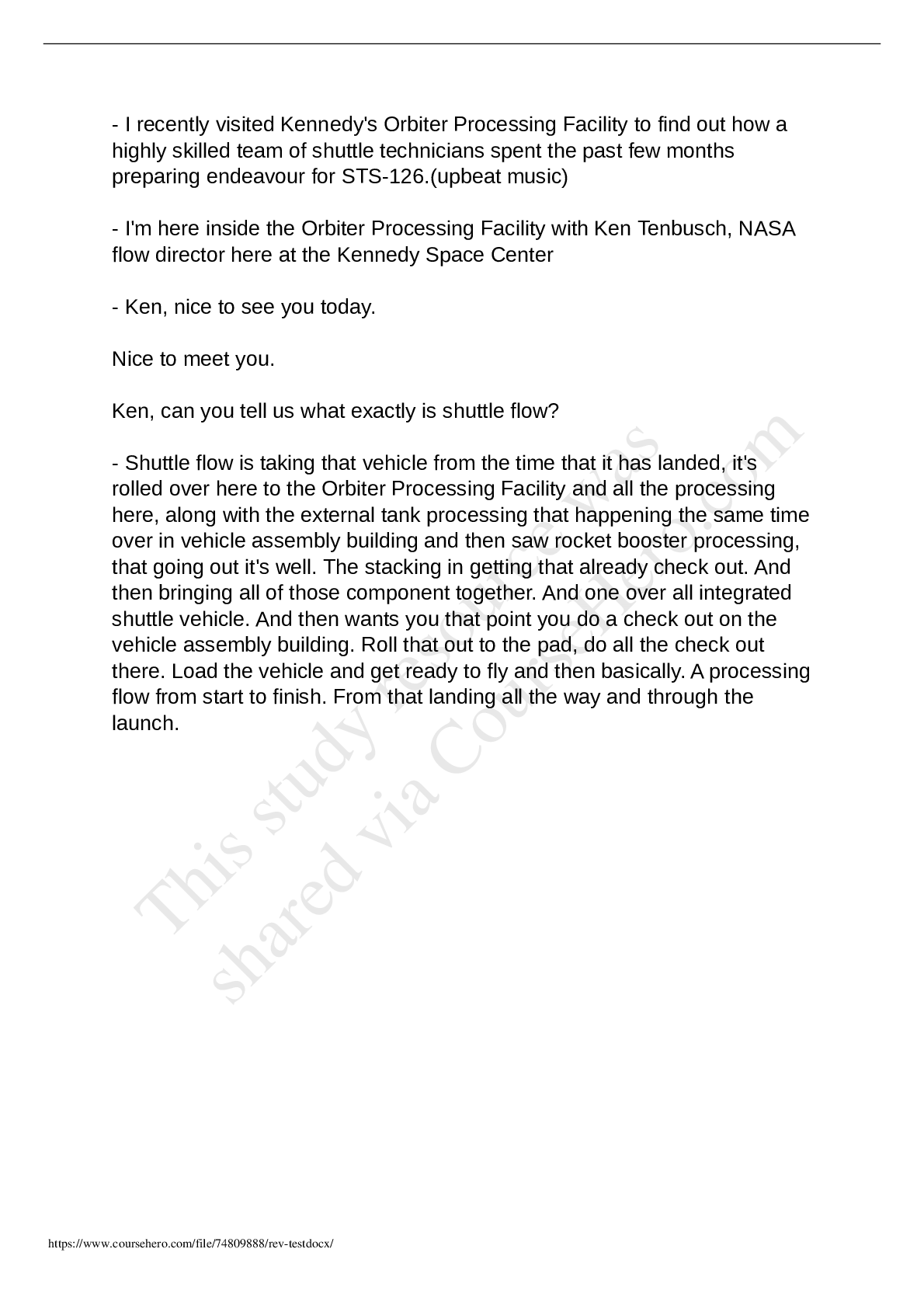

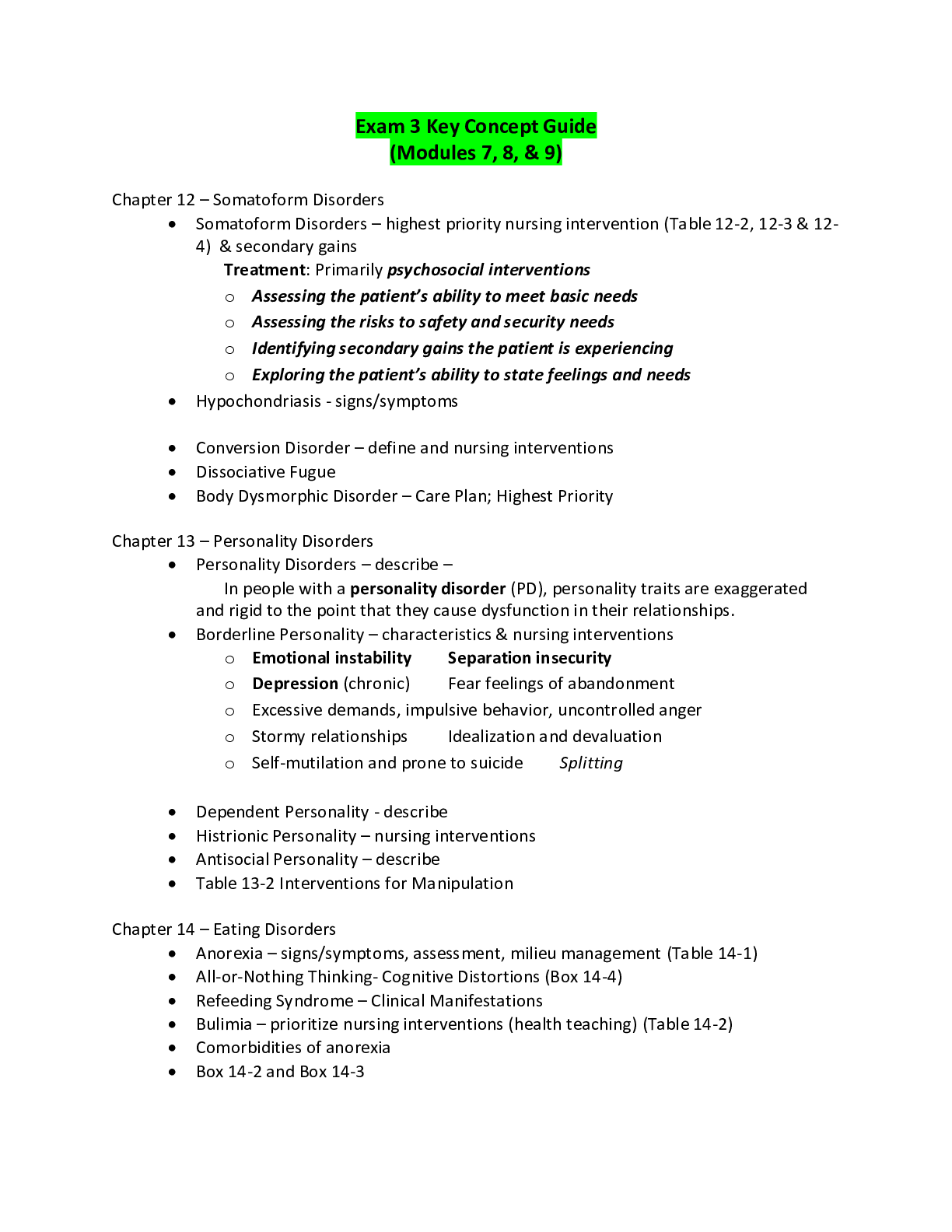
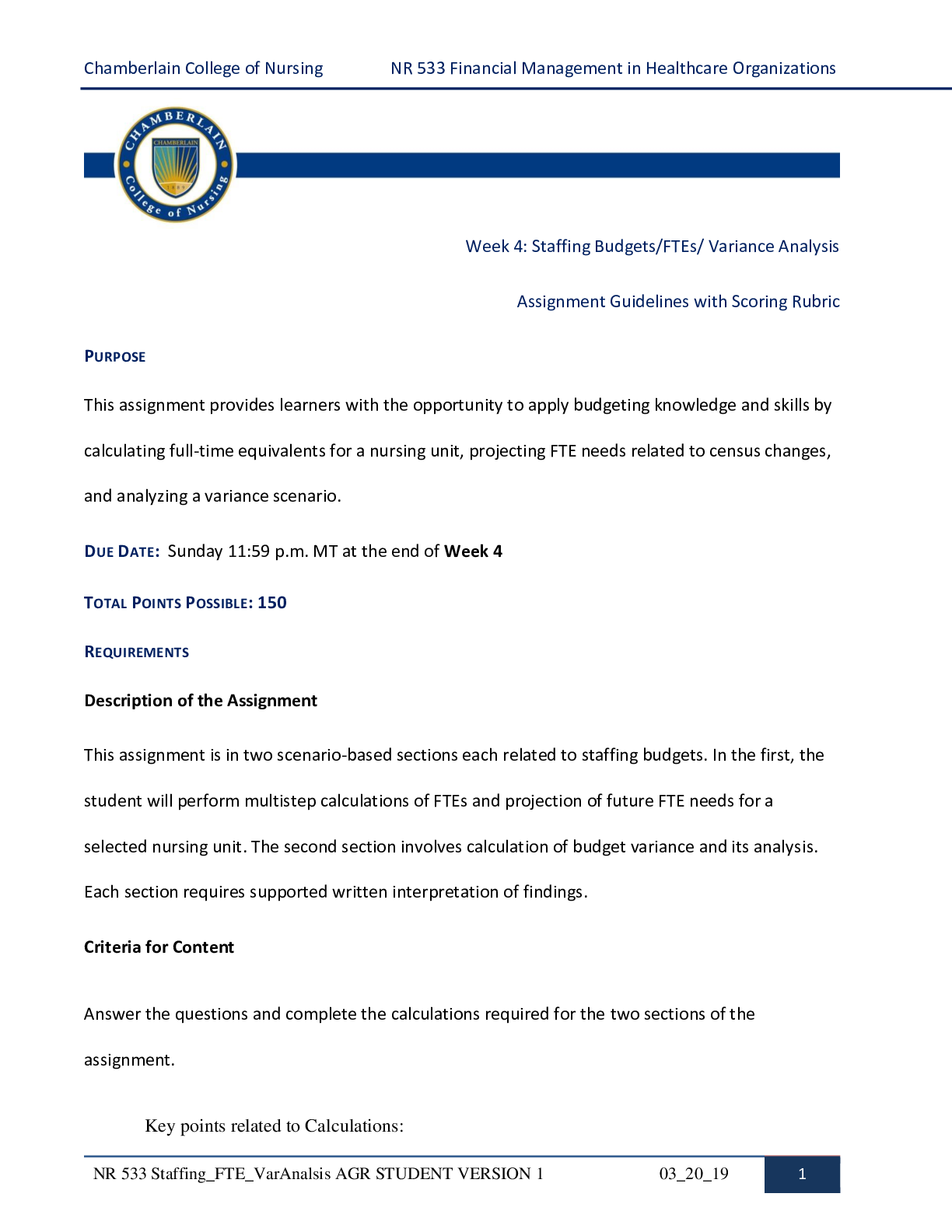
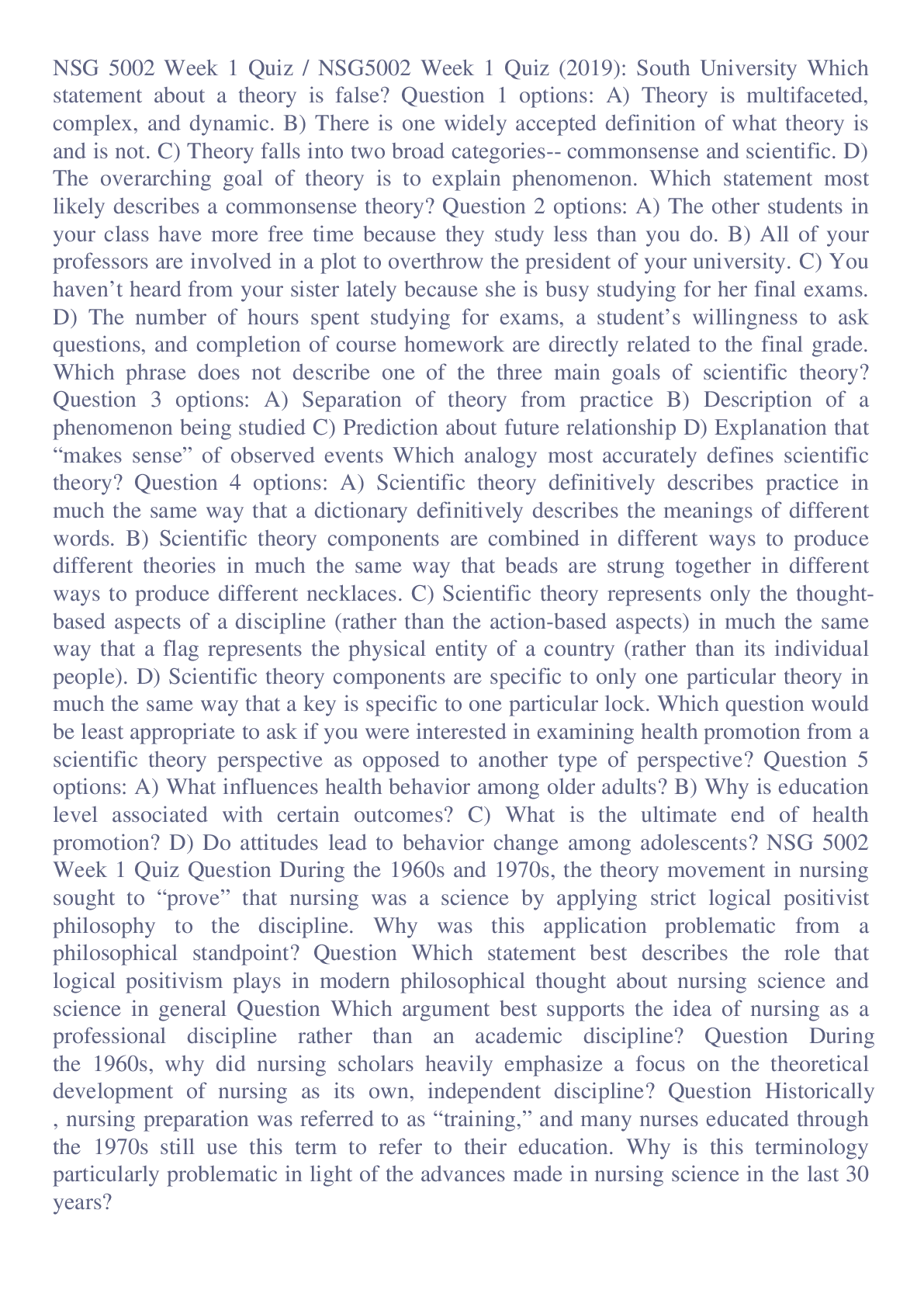
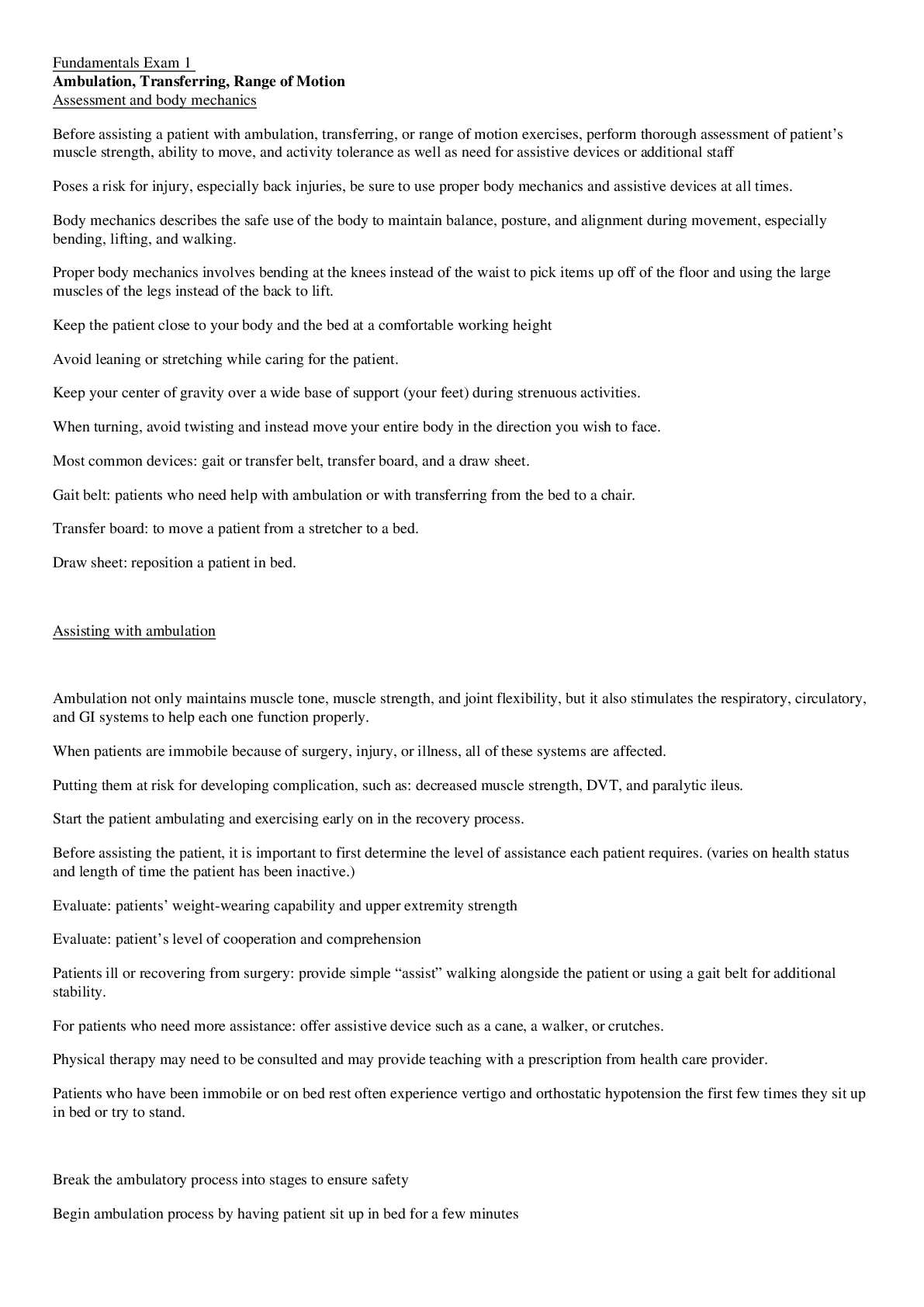
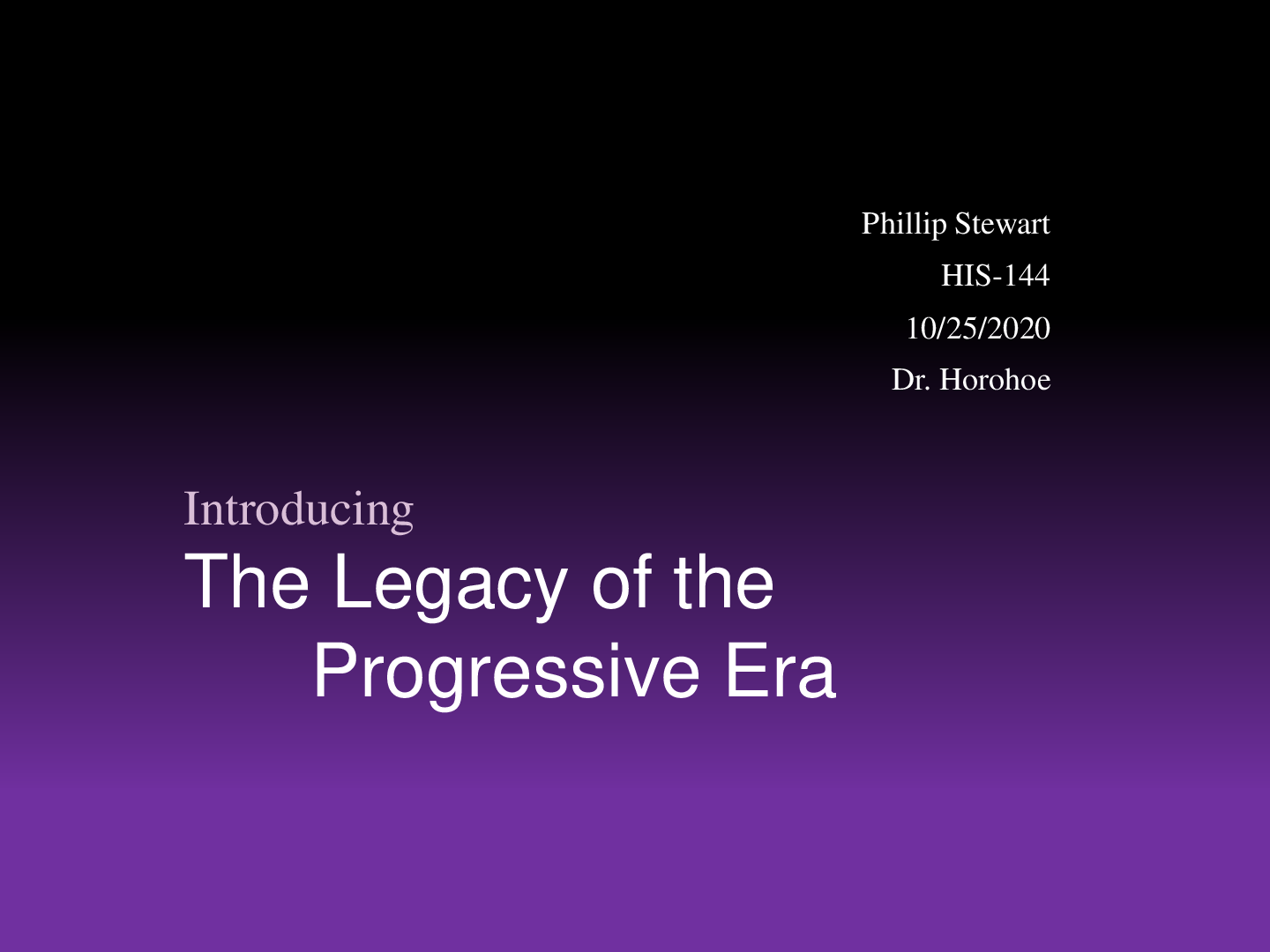
.png)
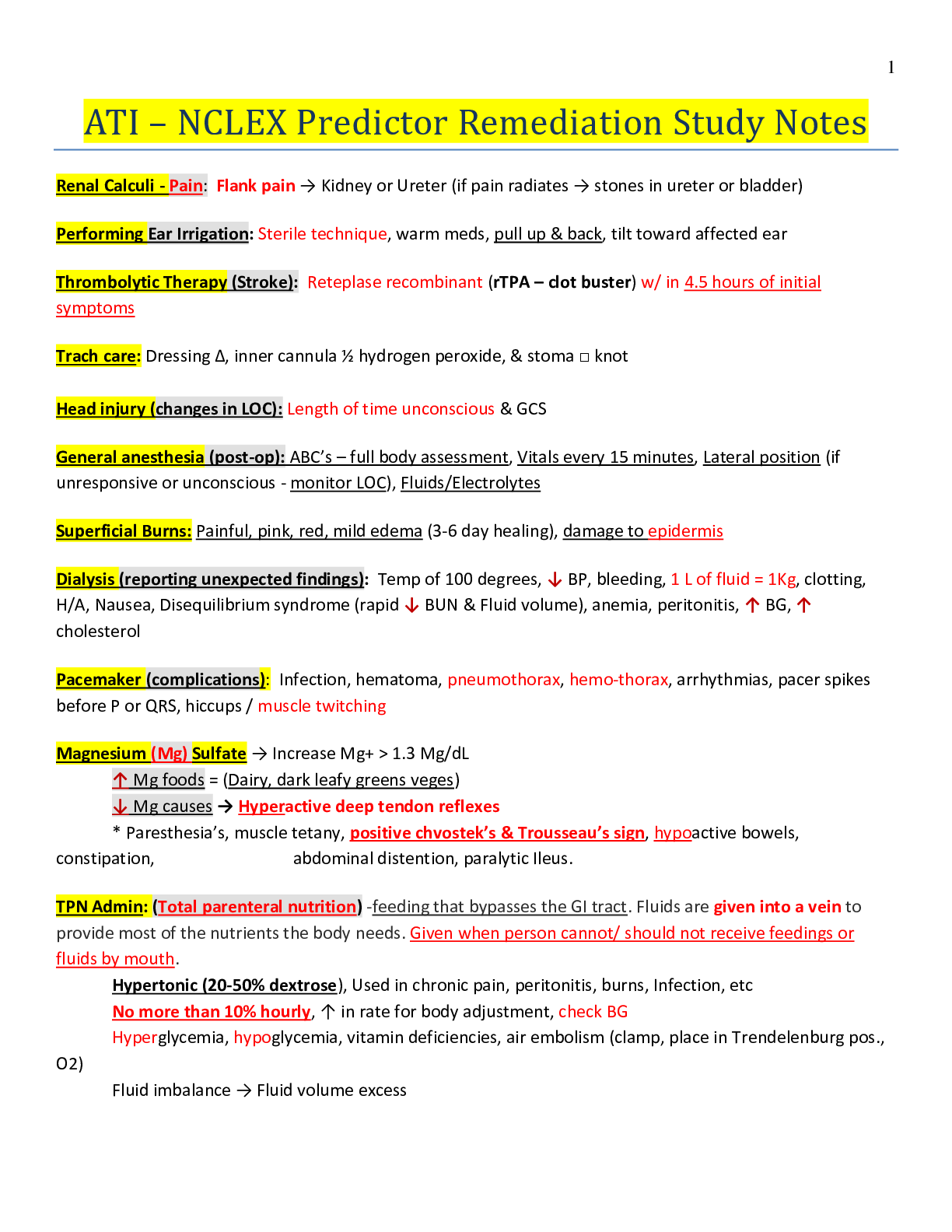


 Rasmussen College.png)
